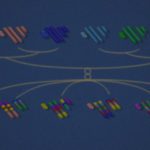Link to Pubmed [PMID] – 12485423
J. Invest. Dermatol. 2002 Dec; 119(6): 1237-43
Pemphigus encompasses a group of autoimmune blistering diseases with circulating pathogenic autoantibodies recognizing several proteins, including the desmosomal cadherin, desmoglein 3. Targeted disruption of the Dsg3 gene by homologous recombination (Dsg3tm1stan) in mouse results in fragility of the skin and oral mucous membranes, analogous to the human disease. In addition, the Dsg3tm1stan mice develop phenotypic runting and hair loss, identical to that of the mouse mutant, Dsg3bal-2J. The Dsg3bal-2J mice are homozygous for a 1 bp insertion (2275insT) in the Dsg3 gene resulting in a nonfunctional Dsg3 mRNA. In this study, we characterized an allelic mutation, Dsg3bal-Pas, with clinical features similar to those in Dsg3bal-2J. We have identified a 14 bp deletion in exon 13 of the Dsg3 gene resulting in a frameshift and premature termination codon 7 bp downstream from the site of the deletion and causing a truncation of the desmoglein 3 polypeptide by 199 amino acids, eliminating virtually all of the intracellular domain. We demonstrate that, although a Dsg3 mRNA transcript was detectable in Dsg3bal-Pas skin, the corresponding protein for desmoglein 3 was completely absent in the oral mucosal epithelium of homozygous Dsg3bal-Pas compared with that of +/Dsg3bal-Pas mice. No significant changes in the expression of desmogleins 1 and 2 were detected. To elucidate a potential mechanism causing loss of cell adhesion in the Dsg3bal-Pas mice, we generated a myc-tagged truncated Dsg3bal-Pas desmoglein 3 protein and expressed it in keratinocytes. The myc-tagged truncated Dsg3bal-Pas desmoglein 3 protein was found predominantly in the cytoplasm possibly due to increased proteolytic degradation. Cell surface staining was also detected but was jagged, not linear along the cell-cell border like that observed for the full-length desmoglein 3. The expression of the myc-tagged truncated Dsg3bal-Pas desmoglein 3 protein resulted in a reduction in staining of other desmosomal proteins, including desmoglein 1 and 2, plakophilin 2, and plakoglobin. In addition, the cells expressing myc-tagged truncated Dsg3bal-Pas desmoglein 3 protein underwent dramatic changes in cell morphology and exhibited striking extensive filopodia. Collectively, these data showed that the perturbation of desmoglein 3 found in the Dsg3bal-Pas mice resulted in disadhesion of keratinocytes manifested with blistering phenotype.

